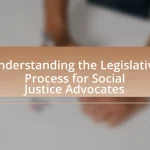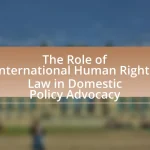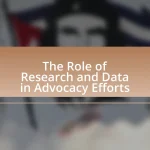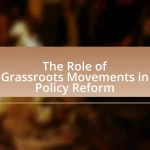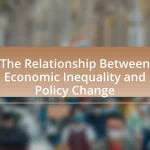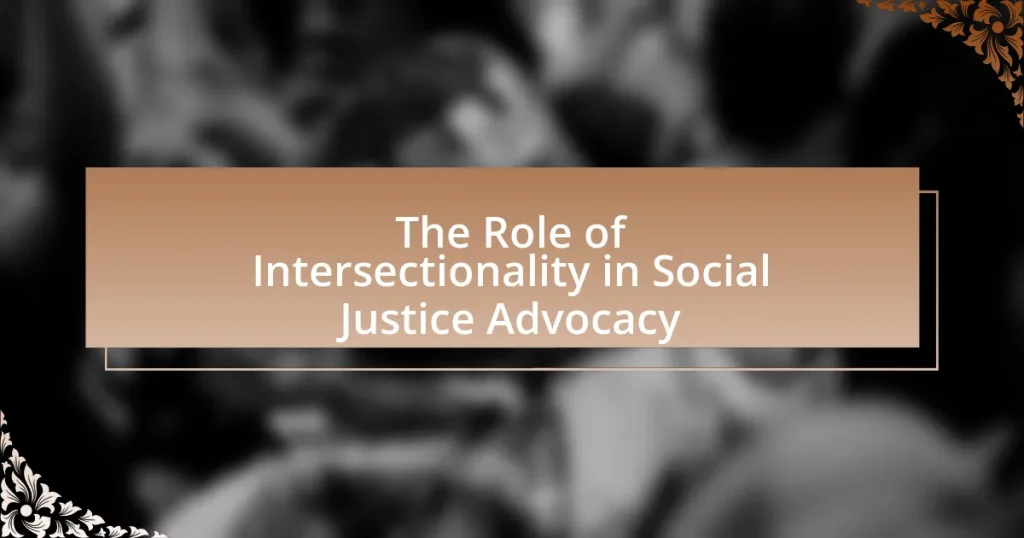Intersectionality is a critical framework in social justice advocacy that examines how various forms of discrimination and oppression intersect, influencing individual experiences. Introduced by Kimberlé Crenshaw, this concept emphasizes the interconnectedness of social identities such as race, gender, sexuality, and class, which collectively shape unique dynamics of privilege and disadvantage. The article explores the influence of intersectionality on social justice movements, key principles in advocacy, and the importance of addressing multiple forms of discrimination to create effective and inclusive strategies. It also discusses the challenges advocates face when applying intersectionality, common misconceptions, and best practices for ensuring diverse voices are represented in advocacy efforts.
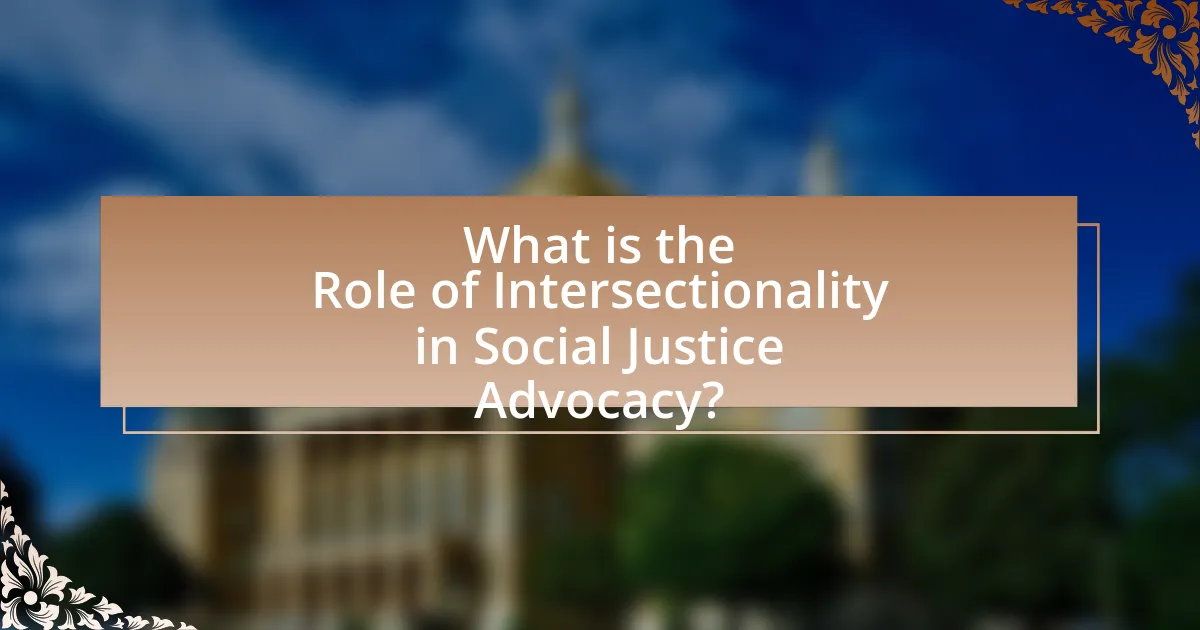
What is the Role of Intersectionality in Social Justice Advocacy?
Intersectionality plays a crucial role in social justice advocacy by highlighting how various forms of discrimination and oppression intersect and compound individual experiences. This framework, introduced by Kimberlé Crenshaw in 1989, emphasizes that social identities—such as race, gender, sexuality, and class—do not exist independently but interact to create unique dynamics of privilege and disadvantage. For instance, a Black woman may face both racial and gender discrimination simultaneously, which cannot be fully understood by examining either identity in isolation. Research shows that intersectional approaches lead to more effective advocacy strategies, as they address the complexities of marginalized experiences, thereby fostering inclusivity and equity in social justice movements.
How does intersectionality influence social justice movements?
Intersectionality influences social justice movements by highlighting the interconnected nature of social categorizations such as race, gender, and class, which create overlapping systems of discrimination or disadvantage. This framework allows activists to understand that individuals experience oppression in varying degrees based on their multiple identities, leading to more inclusive and effective advocacy strategies. For instance, the Combahee River Collective, a group of Black feminists, articulated in their 1977 statement that the liberation of all oppressed people is necessary for the liberation of any one group, emphasizing the importance of addressing multiple forms of inequality simultaneously. This understanding has led to more comprehensive policies and initiatives that consider the diverse experiences of marginalized communities, ultimately strengthening social justice movements.
What are the key principles of intersectionality in advocacy?
The key principles of intersectionality in advocacy include recognizing the interconnectedness of social identities, understanding how these identities shape experiences of oppression and privilege, and promoting inclusive practices that address multiple forms of discrimination. Intersectionality emphasizes that individuals do not experience social categories such as race, gender, and class in isolation; rather, these identities intersect to create unique experiences. For example, a Black woman may face both racial and gender discrimination simultaneously, which cannot be fully understood by examining race or gender alone. This principle is supported by Kimberlé Crenshaw’s foundational work on intersectionality, which highlights the necessity of considering multiple identities in social justice efforts to create effective advocacy strategies that address the complexities of systemic inequality.
How does intersectionality address multiple forms of discrimination?
Intersectionality addresses multiple forms of discrimination by recognizing that individuals experience overlapping identities, such as race, gender, sexuality, and class, which can compound their experiences of oppression. This framework highlights how systemic inequalities are interconnected, meaning that addressing one form of discrimination without considering others can lead to incomplete solutions. For example, a study by Crenshaw in 1989 illustrated how Black women face unique challenges that are not fully addressed by either feminist or anti-racist movements alone, demonstrating the necessity of an intersectional approach in social justice advocacy.
Why is intersectionality important in understanding social justice?
Intersectionality is important in understanding social justice because it reveals how various social identities, such as race, gender, class, and sexuality, intersect to create unique experiences of oppression and privilege. This framework allows advocates to recognize that individuals do not experience discrimination or advantage based solely on one identity but rather through the complex interplay of multiple identities. For instance, a study by Crenshaw in 1989 highlighted how Black women face discrimination that is not fully captured by examining race or gender in isolation, demonstrating that policies addressing social justice must consider these overlapping identities to be effective. By applying an intersectional lens, social justice movements can better address the diverse needs of marginalized groups, ensuring that advocacy efforts are inclusive and equitable.
How does intersectionality enhance the effectiveness of advocacy efforts?
Intersectionality enhances the effectiveness of advocacy efforts by recognizing and addressing the multiple, overlapping identities and experiences individuals possess, which influence their social positioning and access to resources. This approach allows advocates to tailor their strategies to meet the specific needs of diverse groups, ensuring that marginalized voices are included and represented. For example, research by Crenshaw highlights how Black women face unique challenges that are not fully addressed by either feminist or anti-racist movements alone, demonstrating the necessity of an intersectional framework in advocacy. By employing intersectionality, advocacy efforts can create more inclusive policies and practices that effectively address systemic inequalities, ultimately leading to more equitable outcomes.
What are the limitations of traditional social justice approaches without intersectionality?
Traditional social justice approaches without intersectionality fail to address the complexities of individual identities and experiences, leading to oversimplified solutions that do not effectively serve marginalized groups. These approaches often prioritize a single-axis framework, typically focusing on one aspect of identity, such as race or gender, while neglecting how multiple identities intersect and compound discrimination. For instance, a study by Crenshaw (1989) highlights how Black women face unique challenges that are not adequately addressed by frameworks that consider race and gender separately. Consequently, traditional methods can perpetuate inequalities by overlooking the specific needs of individuals who exist at the intersections of various social categories, ultimately resulting in ineffective advocacy and policy outcomes.

How do different identities intersect in social justice advocacy?
Different identities intersect in social justice advocacy by shaping individuals’ experiences of oppression and privilege, which informs their advocacy strategies and goals. For instance, a person who identifies as both a woman and a member of the LGBTQ+ community may face unique challenges that differ from those experienced by a heterosexual woman or a cisgender man. This intersectionality highlights the need for inclusive approaches that address the specific needs of diverse groups, as evidenced by the work of scholars like Kimberlé Crenshaw, who coined the term “intersectionality” to describe how overlapping social identities can compound discrimination. Research shows that advocacy efforts that consider these intersecting identities are more effective in addressing systemic inequalities, as they create a more comprehensive understanding of the issues at hand.
What identities are commonly considered in intersectional advocacy?
Intersectional advocacy commonly considers identities such as race, gender, sexual orientation, socioeconomic status, ability, age, and ethnicity. These identities intersect to create unique experiences of oppression and privilege, which are essential for understanding social justice issues. For example, Black women face different challenges than white women or Black men due to the intersection of race and gender, as highlighted in the work of Kimberlé Crenshaw, who coined the term “intersectionality.” This framework emphasizes that social justice advocacy must address the complexities of these overlapping identities to effectively combat systemic inequalities.
How do race, gender, and class intersect in social justice issues?
Race, gender, and class intersect in social justice issues by creating unique experiences of oppression and privilege that vary based on an individual’s identity. For instance, Black women face both racial and gender discrimination, which can lead to compounded disadvantages in areas such as employment, healthcare, and criminal justice. Research by the American Psychological Association highlights that individuals at the intersection of multiple marginalized identities often experience higher rates of violence and economic disparity compared to those who face discrimination based on a single identity. This intersectional framework is essential for understanding the complexities of social justice advocacy, as it reveals how systemic inequalities are interconnected and require multifaceted approaches to address them effectively.
What role does sexual orientation play in intersectional advocacy?
Sexual orientation plays a critical role in intersectional advocacy by influencing the unique experiences and challenges faced by individuals within marginalized communities. Intersectional advocacy recognizes that sexual orientation intersects with other identities, such as race, gender, and socioeconomic status, creating distinct forms of discrimination and privilege. For instance, LGBTQ+ individuals of color often encounter compounded biases that differ from those experienced by white LGBTQ+ individuals or heterosexual people of color. This complexity necessitates tailored advocacy strategies that address the specific needs of diverse groups, as highlighted in studies like the “2015 U.S. Transgender Survey,” which revealed that 47% of respondents experienced sexual violence in their lifetime, with rates significantly higher among people of color. Thus, understanding sexual orientation within the framework of intersectionality is essential for effective social justice advocacy.
How can intersectionality be applied in advocacy strategies?
Intersectionality can be applied in advocacy strategies by recognizing and addressing the interconnected nature of social categorizations such as race, gender, class, and sexuality. This approach allows advocates to develop more inclusive policies and initiatives that consider the unique experiences and challenges faced by individuals at the intersections of these identities. For instance, research by Crenshaw (1989) highlights how Black women experience discrimination differently than Black men or white women, emphasizing the need for tailored advocacy efforts that reflect these complexities. By integrating intersectional analysis, advocacy strategies can effectively target systemic inequalities and promote social justice for marginalized groups.
What are effective methods for incorporating intersectionality into campaigns?
Effective methods for incorporating intersectionality into campaigns include conducting thorough demographic research to understand the diverse identities within target communities. This approach allows campaigns to tailor messages and strategies that resonate with various intersecting identities, such as race, gender, sexuality, and socioeconomic status. For instance, the 2018 “March for Our Lives” campaign effectively addressed gun violence by highlighting the unique experiences of marginalized groups, demonstrating how gun violence disproportionately affects communities of color. By integrating these perspectives, campaigns can foster inclusivity and ensure that all voices are represented, ultimately enhancing their impact and reach.
How can advocates ensure diverse voices are represented?
Advocates can ensure diverse voices are represented by actively engaging with underrepresented communities and incorporating their perspectives into advocacy efforts. This can be achieved through methods such as conducting outreach initiatives, forming partnerships with community organizations, and creating inclusive platforms for dialogue. Research indicates that inclusive advocacy leads to more effective policy outcomes, as seen in studies highlighting the positive impact of diverse stakeholder engagement on social justice initiatives. For example, the “Diversity in Advocacy” report by the Center for American Progress emphasizes that policies shaped by diverse voices are more likely to address the needs of all community members, thereby reinforcing the importance of representation in advocacy work.
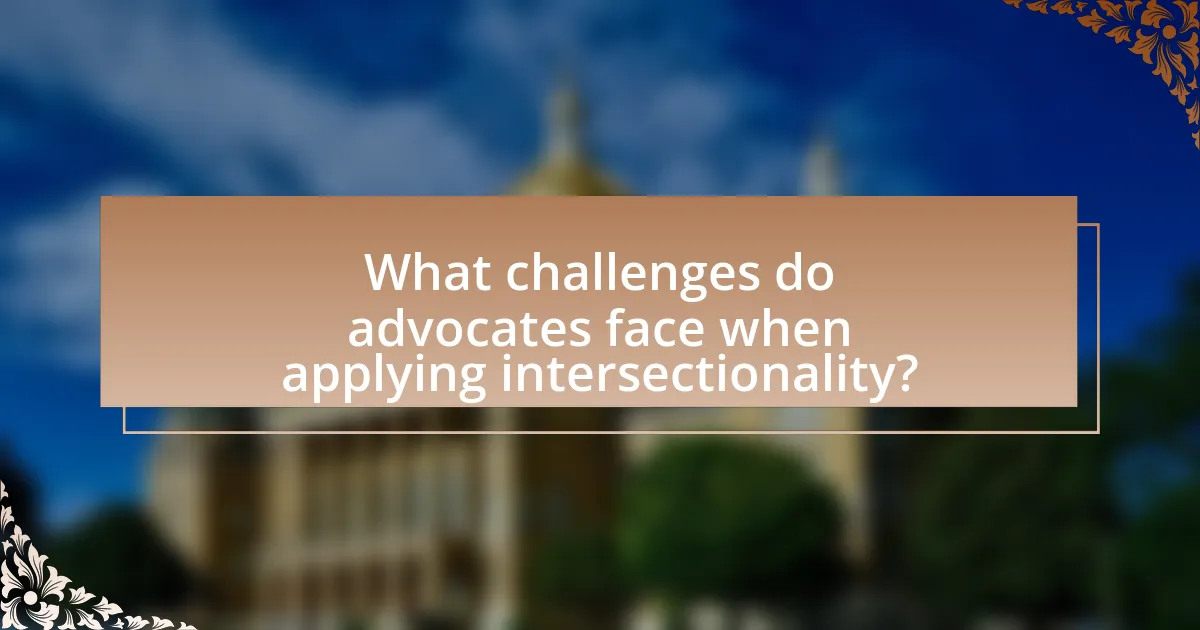
What challenges do advocates face when applying intersectionality?
Advocates face several challenges when applying intersectionality, primarily due to the complexity of overlapping identities and systemic inequalities. This complexity can lead to difficulties in effectively addressing the unique experiences of individuals who belong to multiple marginalized groups. For instance, advocates may struggle to create inclusive policies that adequately represent the needs of diverse populations, as highlighted in the research by Crenshaw (1989), which emphasizes that traditional frameworks often overlook the nuances of intersecting identities. Additionally, advocates may encounter resistance from organizations or individuals who prioritize single-issue approaches, making it challenging to foster a comprehensive understanding of social justice that incorporates intersectional perspectives.
What are common misconceptions about intersectionality in advocacy?
Common misconceptions about intersectionality in advocacy include the belief that it only addresses race and gender, while it actually encompasses a broader range of identities, including class, sexuality, ability, and more. This misunderstanding limits the effectiveness of advocacy efforts by failing to recognize how multiple social identities intersect to create unique experiences of oppression. Additionally, some people mistakenly think that intersectionality promotes a hierarchy of oppression, when in fact it seeks to highlight the interconnectedness of various forms of discrimination. Research by Kimberlé Crenshaw, who coined the term “intersectionality,” emphasizes that understanding these complexities is crucial for effective social justice advocacy.
How can advocates overcome resistance to intersectional approaches?
Advocates can overcome resistance to intersectional approaches by employing education and awareness strategies that highlight the benefits of intersectionality in addressing complex social issues. By providing concrete examples of how intersectional frameworks lead to more effective advocacy outcomes, such as improved policy changes and community engagement, advocates can demonstrate the practical value of these approaches. Research shows that organizations that adopt intersectional strategies are better equipped to address the diverse needs of marginalized communities, leading to more inclusive and equitable solutions. For instance, a study by Crenshaw (2017) emphasizes that intersectionality allows for a deeper understanding of how various forms of discrimination overlap, which can enhance advocacy efforts and foster solidarity among different social justice movements.
What are the risks of oversimplifying intersectional identities?
Oversimplifying intersectional identities risks erasing the complexities and nuances of individual experiences, leading to ineffective advocacy and policy-making. When identities are reduced to singular categories, such as race or gender, the interplay of multiple identities—like socioeconomic status, sexual orientation, and ability—gets overlooked. This can result in a failure to address the specific needs and challenges faced by individuals at the intersections of these identities. For instance, research by Crenshaw (1989) highlights how Black women experience discrimination differently than Black men or white women, emphasizing that policies designed without considering these intersections can perpetuate inequalities. Thus, oversimplification can hinder social justice efforts by promoting one-size-fits-all solutions that do not adequately serve diverse populations.
How can advocates measure the impact of intersectional approaches?
Advocates can measure the impact of intersectional approaches by utilizing both qualitative and quantitative metrics that assess the effectiveness of policies and programs across diverse demographic groups. For instance, surveys and interviews can capture personal experiences and outcomes of individuals affected by multiple intersecting identities, while data analysis can reveal disparities in access to resources or services among different groups. Research indicates that intersectional frameworks can lead to more tailored interventions, as seen in studies like “Intersectionality and Health: A Review of the Literature” by Crenshaw, which highlights how nuanced understanding of identity can improve health outcomes. By combining these methods, advocates can effectively evaluate the real-world implications of intersectional strategies in social justice initiatives.
What metrics can be used to evaluate the effectiveness of intersectional advocacy?
Metrics to evaluate the effectiveness of intersectional advocacy include demographic representation, policy impact, coalition diversity, and participant feedback. Demographic representation assesses whether advocacy efforts engage a diverse range of identities, ensuring that marginalized voices are included. Policy impact measures the extent to which advocacy leads to changes in laws or policies that address intersectional issues, such as the implementation of inclusive policies in education or healthcare. Coalition diversity evaluates the variety of organizations and groups involved in advocacy efforts, indicating a broader representation of interests and experiences. Participant feedback gathers insights from those directly affected by advocacy initiatives, providing qualitative data on the perceived effectiveness and relevance of the efforts. These metrics collectively offer a comprehensive framework for assessing the success of intersectional advocacy initiatives.
How can feedback from marginalized communities inform advocacy practices?
Feedback from marginalized communities can significantly inform advocacy practices by ensuring that the needs and perspectives of these groups are accurately represented and addressed. Engaging with marginalized communities allows advocates to identify specific barriers they face, such as systemic discrimination or lack of access to resources, which can lead to more effective and targeted advocacy strategies. For instance, research by the American Psychological Association highlights that incorporating the voices of marginalized groups leads to more inclusive policies and programs, ultimately resulting in better outcomes for those communities. This evidence underscores the importance of feedback in shaping advocacy that is responsive and equitable.
What are best practices for effective intersectional advocacy?
Effective intersectional advocacy requires a comprehensive understanding of the interconnectedness of various social identities and systemic inequalities. Best practices include actively listening to marginalized voices, ensuring representation from diverse groups in decision-making processes, and employing a collaborative approach that acknowledges and addresses multiple forms of discrimination. Research by Crenshaw (1989) highlights that intersectionality is crucial for understanding how overlapping identities impact individuals’ experiences, thus reinforcing the need for tailored advocacy strategies that consider these complexities. Additionally, utilizing data to inform advocacy efforts can enhance effectiveness; for instance, the 2020 report by the American Psychological Association emphasizes the importance of intersectional data collection in addressing mental health disparities among diverse populations.
How can advocates build coalitions across different identity groups?
Advocates can build coalitions across different identity groups by fostering inclusive dialogue and shared goals. This involves actively engaging representatives from various identity groups to understand their unique challenges and perspectives, thereby creating a foundation of mutual respect and collaboration. Research shows that coalitions that prioritize intersectionality, such as the work of the Women’s March, have successfully united diverse groups by emphasizing common objectives while respecting individual identities. By leveraging shared interests and promoting collective action, advocates can effectively mobilize resources and support across different communities, enhancing the overall impact of their advocacy efforts.
What strategies can be employed to educate others about intersectionality?
To educate others about intersectionality, one effective strategy is to incorporate diverse narratives and personal stories that illustrate the complexities of overlapping identities. This approach allows individuals to understand how various social categories, such as race, gender, and class, interact to shape unique experiences of oppression and privilege. Research by Crenshaw (1989) highlights that intersectionality is crucial for understanding systemic inequalities, as it reveals how traditional frameworks often overlook the experiences of marginalized groups. Workshops and discussions that focus on real-life examples can further enhance comprehension, fostering empathy and awareness among participants.
